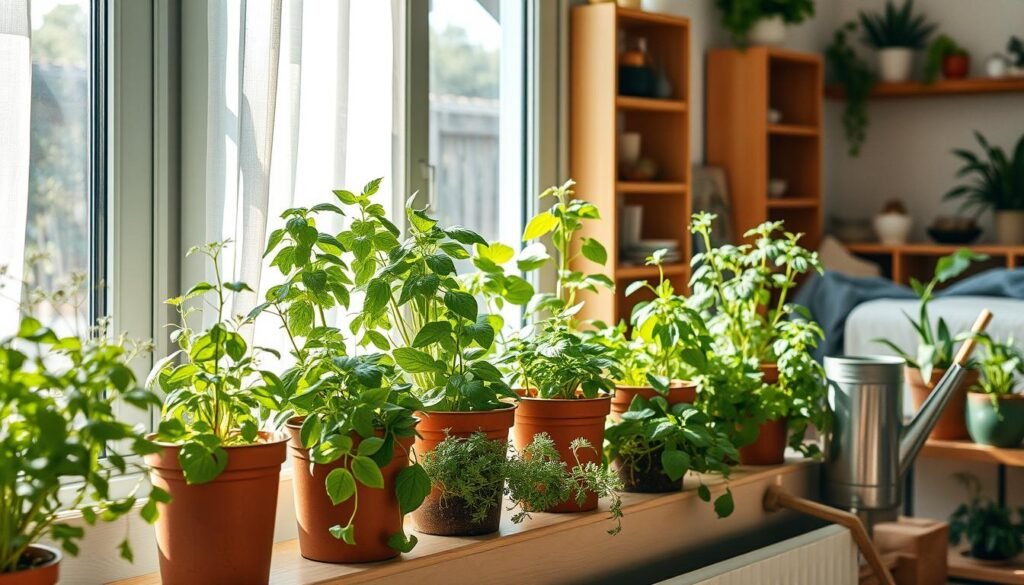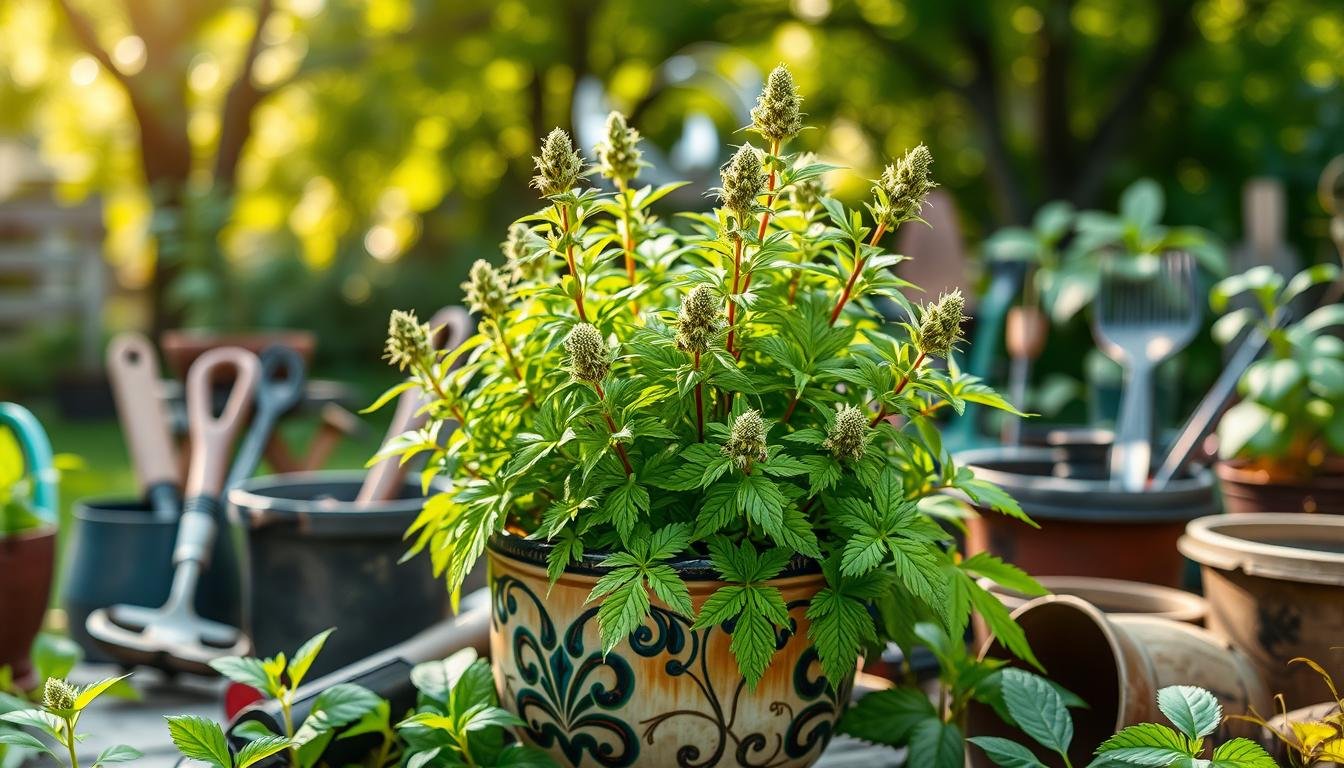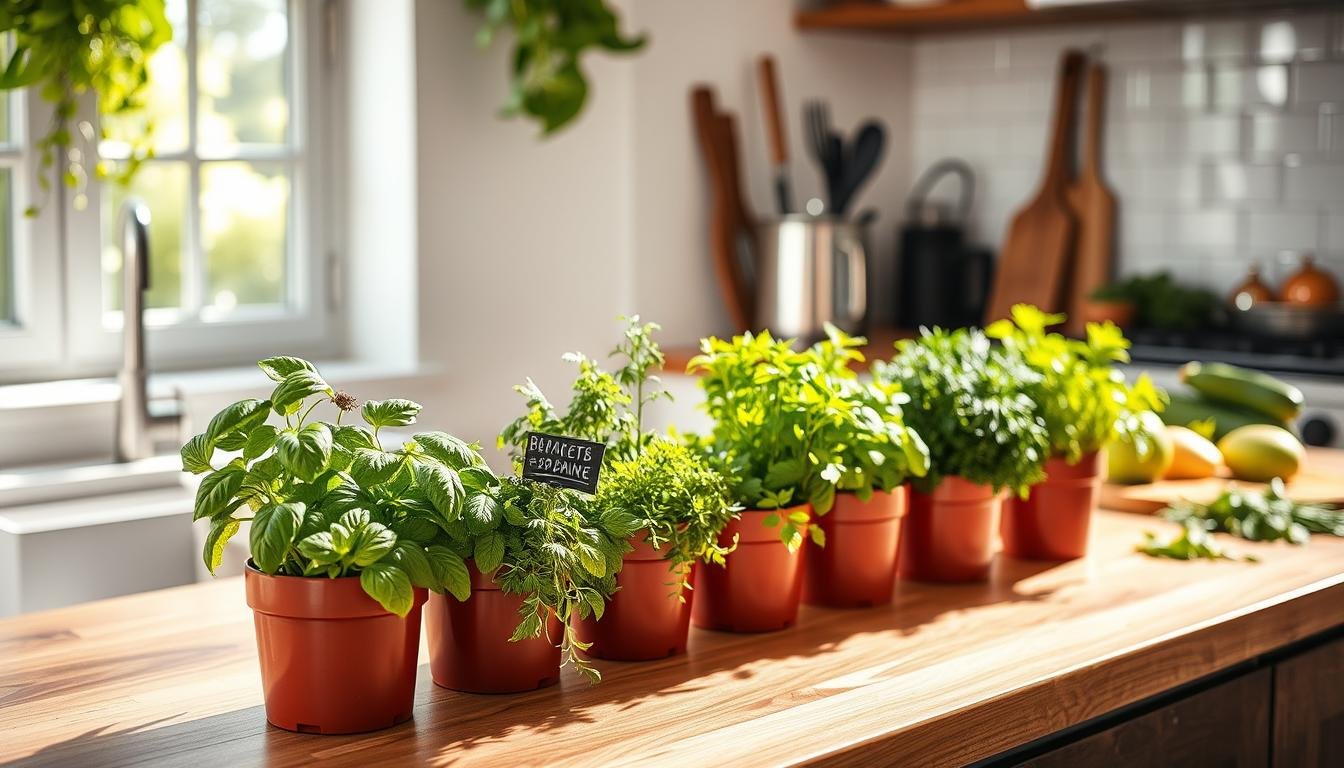Did you know nearly 40% of US food gets wasted, mainly because of how it’s stored and moved? Indoor gardening is becoming more popular for people wanting to live more sustainably. This guide is for anyone interested in growing food inside, especially if you don’t have much room outside but love to garden.
Indoor gardening lets city folks grow their own food right at home. It’s a way to have fresh food all the time and decorate your living space. We’ll help you learn how to choose plants, use your space well, and get a lot of food from your indoor garden. Let’s dive into the world of indoor gardening and join many others doing the same!
Key Takeaways
- Indoor gardening has increased in popularity due to sustainability concerns.
- Even small spaces can support a productive indoor garden.
- Growing your own food indoors can lead to less food waste.
- Access to fresh herbs and vegetables enhances healthy eating habits.
- This beginner’s guide simplifies the process for aspiring gardeners.
Understanding the Benefits of Indoor Gardening
Indoor gardening has many benefits. It supports sustainable living with year-round food production. You can have fresh produce by growing plants in your home. This practice cuts down on food transportation and increases food safety. You get to control what goes into your meals.
When you grow your own food, your health benefits. This is especially true using organic gardening methods. It avoids chemicals and pesticides found in store-bought produce. Enjoying fresh and organic fruits and vegetables from your indoor garden means you’ll eat healthier.
Taking care of plants makes people feel good. It helps reduce stress and boosts your mood. Also, indoor gardening cleans the air. Plants naturally remove toxins, making your home healthier.
Choosing the Right Plants for Indoor Growth
Choosing the right plants is key for growing edible ones indoors. Look for plants that do well in small spaces and containers. This guide will help you pick the best herbs and vegetables for an indoor mini garden.
Herbs That Thrive Indoors
Herbs are great for small areas and pots. They need little care but add a lot of flavor to meals. Here are some to try growing:
- Basil – It makes salads and pasta taste fresh.
- Parsley – A versatile topping for almost any dish.
- Mint – Perfect for teas, cocktails, and sweets.
These herbs not only make your place look nice but also give you fresh ingredients easily.
Vegetables Suitable for Container Gardening
Though many veggies need space, some do well in pots. Choose varieties that fit in small areas:
- Cherry Tomatoes – They’re sweet, great for quick snacks or salads.
- Bell Peppers – They add color and nutrition to many meals.
- Radishes – They grow quickly and are fun to pick.
These vegetables are great choices for an indoor garden. They are productive and fun to grow. With some care, you can have a lively garden at home.
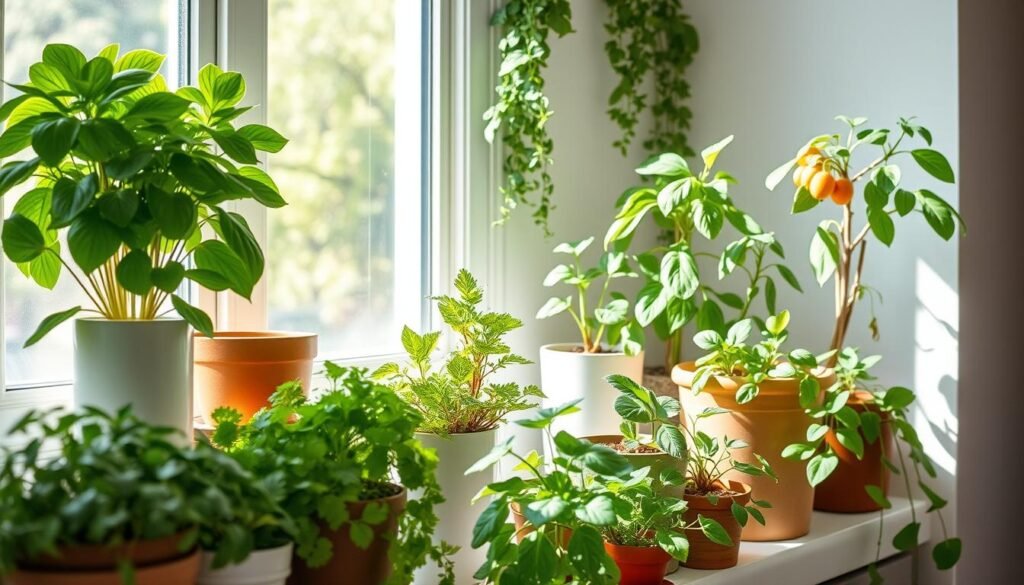
How to Grow Your Own Food Indoors
Starting an indoor garden is exciting for anyone keen on small space farming. Key indoor gardening basics can lead to success. Here are some top tips for beginners. It’s okay to feel unsure at first. But learning more will help you become confident.
Essential Tips for Beginners
- Start simple: Go for easy-to-grow plants like herbs and greens. They’re a great start to indoor gardening.
- Use quality soil: Get a well-draining potting mix for containers. It helps plants grow healthy.
- Monitor moisture: Make sure your plants get enough water, but not too much. Checking daily is best.
- Provide drainage: Use pots with holes to avoid root rot. This keeps plants healthy.
Basic Requirements for Indoor Gardening
Knowing what your plants need makes indoor gardening easier. Keep these points in mind:
| Requirement | Details |
|---|---|
| Lighting | Appropriate light is essential. If natural light is lacking, consider supplemental grow lights. |
| Temperature | Keep temperatures between 65-75°F for the best plant growth. |
| Humidity | Most indoor plants do well with 40-60% humidity. Use a humidifier if needed. |
| Fertilization | Feed your plants monthly with balanced fertilizer for nutrition. |
Setting Up Your Indoor Garden
Planning your indoor garden demands attention to detail. The spot you pick in your home impacts plant growth and health greatly. Light, temperature, and easy access are key. Knowing these will guide you in finding the perfect place for your plants. Also, learning about container gardening helps. You’ll get better at choosing pots, soil, and how to arrange your plants.
Choosing the Best Location
Pick the best spot for your plants by looking at:
- Light Exposure: Spot areas with a lot of natural light, like south-facing windows.
- Temperature Stability: Stay away from drafty spots or places with big temperature changes, such as near heaters or AC units.
- Accessibility: Make sure you can easily reach your plants for watering and trimming.
Container Gardening Essentials
Getting into container gardening can make your indoor garden better. Here’s what to keep in mind:
- Pots: Go for pots with holes at the bottom to avoid waterlogged roots.
- Soil Mixture: Pick a top-notch potting mix made for containers.
- Plant Spacing: Stick to spacing advice to give your plants enough room to grow.
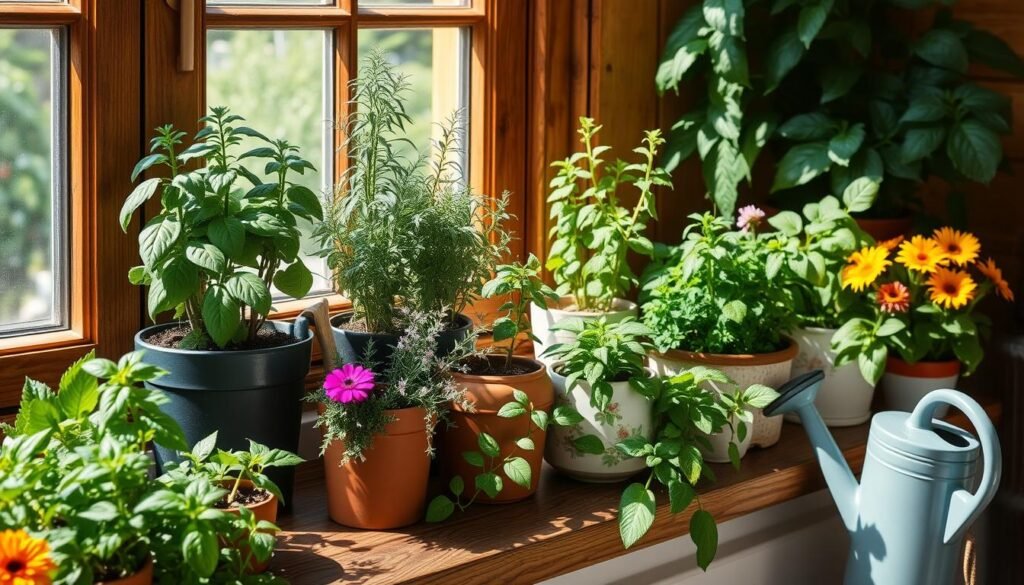
| Factor | Importance | Recommendations |
|---|---|---|
| Light | Crucial for growth and photosynthesis | Position near windows with maximum sunlight |
| Temperature | Affects plant metabolism and growth rate | Maintain steady indoor temperatures |
| Accessibility | Facilitates regular care and maintenance | Choose locations that are easy to reach |
Lighting Solutions for Indoor Plants
Choosing the right lighting is key for indoor garden success. It ensures plants get the energy for photosynthesis, which leads to strong growth. Both natural and artificial light offer benefits for your indoor garden.
Understanding Grow Lights
Grow lights come in various types for indoor gardening. They match different plants and growth stages. Here are the most common types:
- LED Lights: They are energy-efficient and last long. LED lights give off a full light spectrum, perfect for all growth stages.
- Fluorescent Lights: These are budget-friendly and work well for seedlings and small plants.
- High-Intensity Discharge (HID) Lights: HID lights are strong and speed up growth but use more power.
When choosing grow lights, think about the light spectrum, how long the lights are on, and where to place them. Knowing how to use these lights can really help your plants thrive.
Natural Light vs. Artificial Light
Natural light is great for indoor plants, giving warmth and energy. But, not all indoor gardens get enough sunlight. This is when artificial lights are helpful. Each has its own benefits and drawbacks:
| Lighting Type | Advantages | Disadvantages |
|---|---|---|
| Natural Light | It’s free, gives a full spectrum, and supports natural growth cycles | Its availability depends on weather, location, and time of year |
| Artificial Lighting | You can control it, changing the light’s duration and spectrum | It can increase energy bills and produce heat |
Using both natural and artificial light together can make the best environment for your plants.
Hydroponic Systems for Efficient Farming
Hydroponic systems are at the forefront of modern indoor farming. They let people grow plants without soil. This method has many benefits, making it perfect for city dwellers who want to farm sustainably. Learning about the different types of hydroponic systems can make your gardening more enjoyable.
Types of Hydroponic Systems
There are many hydroponic systems, each designed for specific gardening needs. Here are some popular ones:
- Nutrient Film Technique (NFT): A thin layer of nutrient-filled water constantly flows over the roots. This supplies plants with needed nutrients and cuts down on water use.
- Deep Water Culture (DWC): Plants float in a nutrient solution, with roots in oxygen-rich water. This encourages fast growth and strong roots.
- Wick Systems: A wick transports nutrients from a reservoir to the plants. It’s easy to use and great for beginners.
- Drip Systems: Nutrient solution is dripped right onto the roots. This allows precise control over watering and nutrients.
The Advantages of Hydroponics
Hydroponic gardening offers many important benefits. Here are the key advantages:
| Advantage | Description |
|---|---|
| Reduced Water Use | Hydroponic systems use up to 90% less water than traditional farming. |
| Faster Growth Rates | Plants grow quicker in hydroponic systems because they get nutrients and oxygen directly. |
| Less Pest Problems | Without soil, there’s a lower chance of pests and diseases. |
| Space Efficiency | Hydroponics makes it possible to garden upwards, saving space indoors. |
Getting into hydroponic gardening offers many benefits. It lets gardeners grow plants in a modern, efficient way.
Maintaining Optimal Conditions for Growth
To grow a thriving indoor garden, it’s key to keep conditions right for your plants. They need the correct temperature and humidity. Also, watering them right is vital. Doing these can boost your indoor plants’ health and how much they grow.
Understanding Temperature and Humidity
Keeping your plants at the right temperature is crucial. They like it best between 65°F and 75°F. If the temperature changes too much, it can hurt them, making them stop growing or even die.
Keeping the air around your plants moist enough is also important. They do well when humidity is between 40% and 60%. If it’s too dry, leaves might fall or bugs might come. Too much moisture can make mold grow. Using a hygrometer can help you keep an eye on humidity. You can also try humidity trays, misting, or a humidifier to help.
Watering Techniques for Indoor Plants
Knowing how much water your plant needs is key to not overdoing it. Overwatering can really harm them. A good tip is to feel the soil an inch down. If it’s dry, it’s time to water.
Different ways to water can help make sure your plants get just enough:
- Bottom watering: Put water in a tray and let the pot soak it up from below.
- Using moisture meters: These tools tell you how wet the soil is, so you know when to water.
- Drip irrigation systems: Great for a lot of plants, this gives water right to the roots slowly.
| Watering Technique | Benefits | Best For |
|---|---|---|
| Bottom Watering | Stops too much water and helps roots grow deep. | Plants in big pots or with roots that need care. |
| Moisture Meters | Keeps you from watering too much and helps water regularly. | All indoor plants. |
| Drip Irrigation | Gives you control over how much water goes to the plants. | Big indoor gardens or places with many different plants. |
Urban Farming: Making the Most of Your Space
In city settings, finding enough room to grow food can be hard. But, you can really make the most of your small area with smart urban farming methods. Vertical gardening and using little spaces wisely are key. These ways help you use every bit of space and grow a variety of plants.
Vertical Gardening Ideas
Vertical gardening is a cool way to farm in the city. It lets you create green spots without taking up much ground space. You can use wall planters, hang pots, or put up trellises to grow different plants. This also makes your place look nicer. Here are some tips:
- Install wall-mounted planters for herbs.
- Use vertical racks for climbing veggies like peas and cucumbers.
- Incorporate shelf systems to stack plants.
- Turn fences into green walls with climbers.
Utilizing Small Spaces for Maximum Yield
You can turn tiny areas of your place into a thriving garden. Just follow some simple advice:
- Place small pots on sunny windowsills.
- Hang plants or pots on balcony railings.
- Pick small plant types, like dwarf tomatoes and mini peppers.
- Stack pots to create levels of garden space.
With these urban farming ideas, you can grow your own food and enjoy a beautiful green spot at home. You don’t need a lot of space to make it happen.
Starting Your Indoor Garden with Microgreens
Microgreens are great for beginners who want to grow food inside. These small plants are full of flavor and nutrients. They come loaded with vitamins, minerals, and antioxidants. This makes them a healthy choice for any dish. Plus, they don’t need much space to grow.
The Benefits of Growing Microgreens
Growing microgreens inside is both easy and rewarding. They grow fast, sprouting in just a week or so. This means you can quickly enjoy what you grow. Besides their nutritional value, microgreens can boost the taste of salads, sandwiches, and more. They also don’t need much equipment, perfect for those with little space.
How to Grow Microgreens in Small Containers
Start with seeds like arugula, radish, or basil. You can find these at garden centers or online. Use a shallow container with good potting mix to ensure drainage. Scatter the seeds and cover them lightly with the soil. Keep the soil just moist and place the container somewhere bright. Soon, you’ll have a lush microgreen crop to enjoy. With little effort, you can experience the fresh flavors and benefits of microgreens at home.
